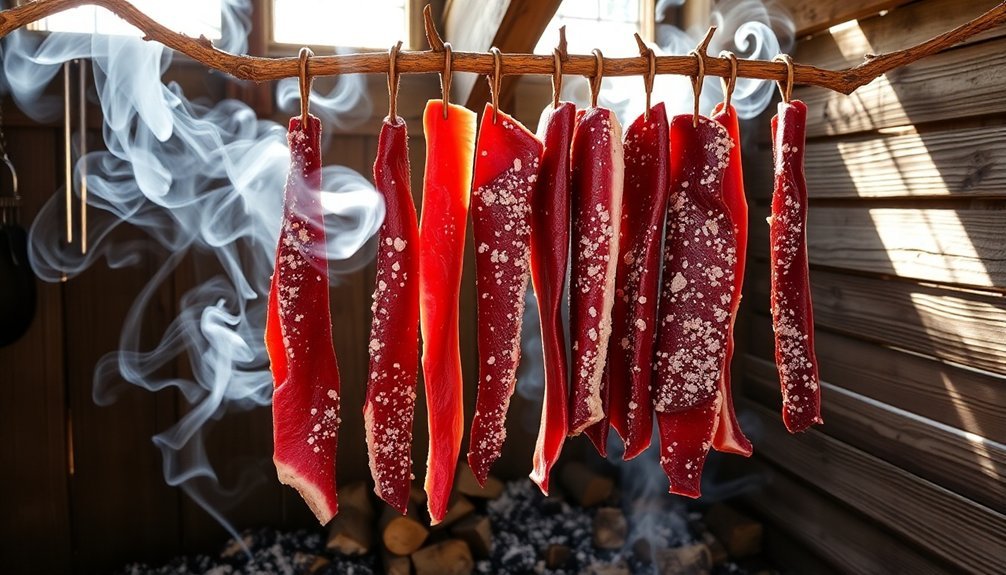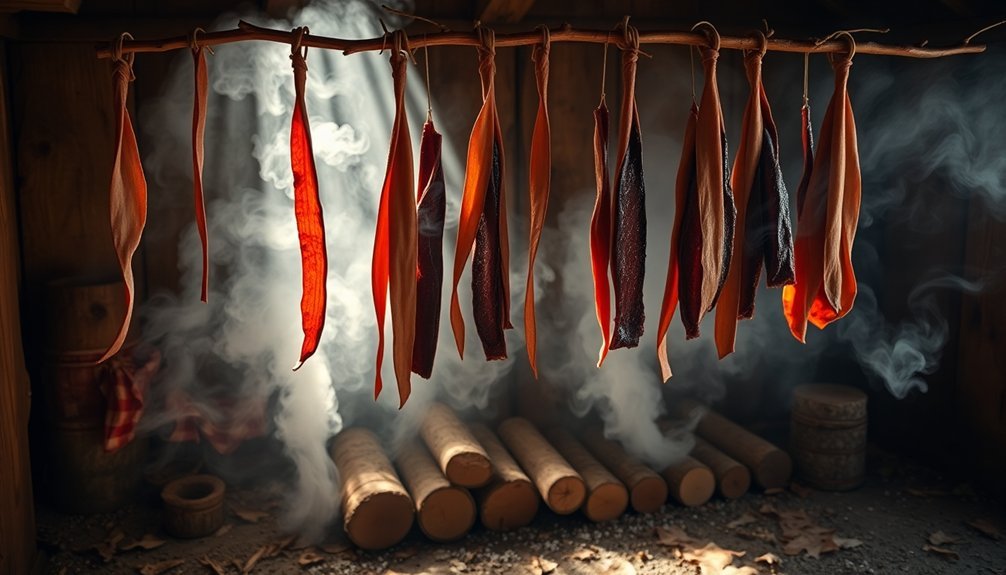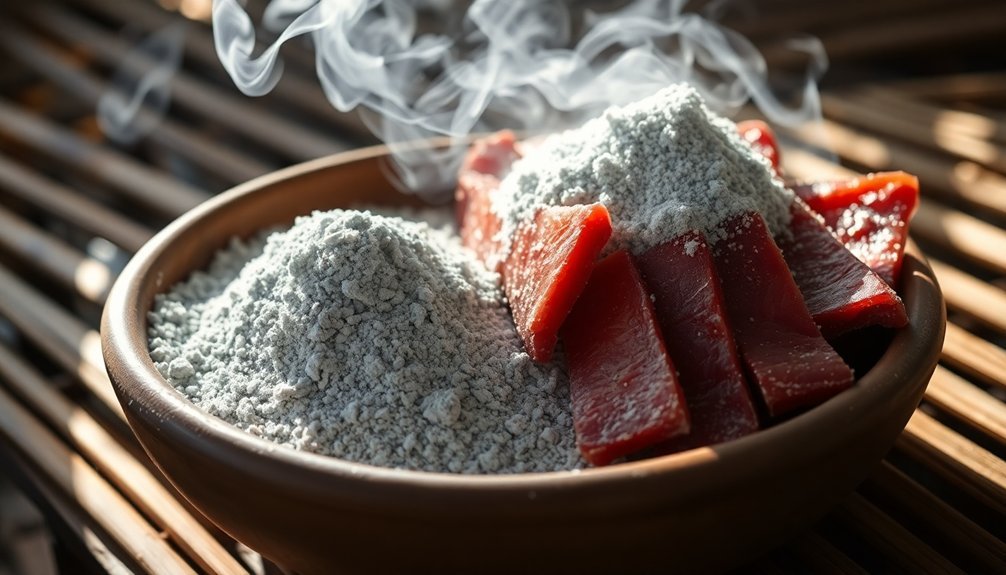Five remarkable indigenous ash preservation methods can help you store meat without modern refrigeration. The Cherokee Hickory Ash technique uses sifted ash for months-long preservation, while the Bukusu's mushelekha method employs potassium-rich plant ash to tenderize and preserve meat. Oak Wood preservation creates a protective barrier using hardwood ash, and the Stoneware Ash system combines pottery with ash layers for ideal storage. You'll also find the Traditional Banana Peel Ash approach offers a simple yet effective preservation solution. These time-tested techniques showcase ancestral wisdom that continues to offer practical food storage solutions today.
Cherokee Hickory Ash Method

Down through the generations, Cherokee people preserved their meat using a distinctive method involving hickory ash. This traditional technique not only extended the shelf life of meat but also enhanced its flavor, making it particularly valuable in humid regions where other preservation methods might fail.
You'll need to start by sifting the hickory ash to remove larger particles, ensuring even coverage of the meat. Modern testing has shown that this method can help extend food viability from months to years. When you're ready to preserve your meat, place it in an earthenware crock, making sure the pieces don't touch each other. Cover the meat completely with the sifted ash, as full coverage is essential for effective preservation.
The preservation process works through multiple mechanisms. The sterile nature of wood ash inhibits microbial growth while deterring pests, and it helps absorb moisture that could lead to spoilage.
You'll want to store your ash-covered meat in a cool, dark place, like a cellar, to slow biological processes further. If you smoke the meat before storing it in ash, you'll add an extra layer of preservation.
When you're ready to use the preserved meat, you'll need to remove any ash-covered rind, though it often dusts off easily.
Bukusu Bean Ash Storage
Among the Bukusu people of the Luhya community, a unique preservation method called mushelekha transforms ordinary ash into a powerful meat preservative.
You'll need to let the treated meat cure for at least 48 hours in a cool place before consumption, similar to other preservation methods. You'll find this traditional technique relies on ashes from burnt bean pods, maize cobs, sorghum husks, and banana peels, which are carefully processed in a special filtration pot called lushelekho.
To create mushelekha, you'll need to burn these plant materials and mix the resulting ash with water in the lushelekho pot. The pot's holes allow the potassium-rich filtrate to drip through slowly, creating a solution that's perfect for meat preservation.
You can store this filtrate for later use in your meat preparation process.
When you apply mushelekha to meat, you'll notice it does more than just preserve – it tenderizes tough cuts and enhances their flavor.
The solution helps maintain the meat's texture while reducing spoilage, making it an effective preservation method that's both sustainable and practical.
What makes this technique particularly valuable is its use of readily available materials, ensuring you can continue this preservation practice using local resources from your community.
Oak Wood Preservation Technique

Similar to the Bukusu's use of bean ash, the indigenous practice of oak wood ash preservation has stood the test of time as a reliable meat storage method. Cherokee people, among other indigenous groups, mastered this technique, which proved especially effective for preserving meats like bacon without refrigeration.
You'll need to start by selecting high-quality oak or hickory wood ash, guaranteeing it's properly sifted to achieve a fine, even consistency. Like the wire brush technique, thorough processing of the ash ensures optimal texture and effectiveness. It's essential to keep the ash dry and free from any contaminants that could compromise the preservation process.
When you're ready to preserve your meat, you'll cover it completely with the prepared ash, which works to absorb moisture and prevent spoilage while adding a subtle flavor to the meat.
For storage, you'll want to place your ash-covered meat in an airtight container, preferably a stoneware crock, and keep it in a cool, dry location like a cellar. You'll need to check your stored meat regularly to verify the ash remains dry and effective.
When done correctly, this method can preserve your meat for several months, making it an invaluable technique for long-term food storage.
Stoneware Ash Preservation System
Traditional stoneware vessels form the foundation of an effective ash preservation system that has protected meats and cheeses for generations.
You'll need a sturdy stoneware pot or crock, clean hardwood ashes that you've carefully sifted, and thick cuts of meat or cheese to guarantee the best preservation results.
To implement this system, place your meat or cheese in the stoneware container and surround it with 1 to 1.5 inches of sifted wood ashes.
You'll want to ascertain complete coverage, adding more ash on top if needed. While a stoneware lid can enhance the preservation, it's not essential.
Store your container in a cool, dry cellar away from sunlight and heat sources.
The wood ash creates a protective barrier that keeps moisture away from your food while deterring pests like insects and mites.
You can preserve cheese for up to three months using this method, and it may even enhance the flavor through an aging-like process.
Remember to use only clean hardwood ashes, avoiding any from treated wood or contaminated sources.
Always inspect your preserved food for spoilage before consuming, as results can vary based on conditions.
Traditional Banana Peel Ash

Discovering the preservative power of banana peel ash opens up a fascinating method of meat preservation that's both effective and sustainable. You'll find this traditional technique particularly useful for long-term storage, as it can keep meat edible for up to six months without requiring modern refrigeration.
To use this method, you'll need to dry your meat thoroughly and then cover it with ash made from burned banana peels. You can hang the meat on sticks during the preservation process, ensuring it's completely coated with the ash. The drying process removes moisture, while the ash's natural antimicrobial properties protect against spoilage.
You aren't limited to just banana peel ash – you can also use ash from beans and legumes, which contain similar chemical properties. These ashes offer versatility beyond meat preservation; they're effective at softening vegetables and reducing cooking time for hard-to-cook beans by decreasing phytate content.
What makes this indigenous method particularly valuable is its simplicity – you won't need special temperature controls or humidity monitoring. It's a time-tested technique that's been passed down through generations, proving its reliability in preserving meat for ceremonies and times of abundance.
Frequently Asked Questions
How Long Must Meat Dry Before Applying Ash Preservation Methods?
You'll need to dry your meat for 14-21 days until it's leathery and has low moisture content. The exact time depends on your drying method, temperature, humidity, and meat thickness.
Can Different Types of Ash Be Mixed for Better Preservation?
While you could mix different ash types, there's no historical evidence supporting better preservation from combinations. You'll get more reliable results sticking to one proven type like hickory or hardwood ash.
What Signs Indicate Ash-Preserved Meat Has Spoiled?
You'll know your ash-preserved meat has spoiled if you notice a sour or ammonia smell, slimy texture, greenish discoloration, or mold growth. Watch for surface tackiness and any unusual off-putting odors.
Does Altitude Affect the Effectiveness of Ash Preservation Techniques?
You won't notice significant altitude effects on ash preservation. What really matters is keeping your storage area cool, dry, and dark. Altitude itself isn't as important as controlling temperature and humidity levels.
How Does Seasonal Temperature Variation Impact Ash Preservation Storage Times?
You'll find your preserved meat lasts longer in cold seasons, up to 3 weeks when refrigerated. During warmer temperatures, storage time drops considerably to 3-5 days, even with proper ash preservation techniques.
In Summary
You've now explored five time-tested indigenous ash preservation methods that'll help you keep meat fresh without modern refrigeration. Whether you're using Cherokee hickory ash, Bukusu bean ash, oak wood, stoneware, or banana peel ash, these techniques have sustained communities for generations. Try incorporating these methods into your food preservation routine – you'll be amazed at how effective they are while honoring traditional wisdom and sustainable practices.





Leave a Reply